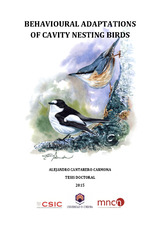Behavioural adaptations of cavity nesting birds
Autor
Cantarero Carmona, Alejandro
Director/es
Moreno Klemming, JuanRedondo-Villa, Alberto
Editor
Universidad de Córdoba, UCOPressFecha
2015Materia
NidifcaciónCavidades de nidificación
Pájaros
Comportamiento
Ectoparásitos
Propiedades térmicas
Adaptación
Nests
Birds netst
Birds
Behavior
Ectoparsites
Adaptation
METS:
Mostrar el registro METSPREMIS:
Mostrar el registro PREMISMetadatos
Mostrar el registro completo del ítemResumen
Nesting cavities offer conditions of relatively constant temperature and humidity
as well as protection from rain, solar radiation and. Availability of nesting cavities,
thermal properties of the nests and ectoparasites loads are among the main factors
implicated in the evolution of cavity nesting behaviour. The main goal of this thesis
is increased understanding from an evolutionary perspective of the behavioural
strategies arising during several stages of the reproductive cycle in small altricial
cavity-nesting birds such as the Pied Flycatcher Ficedula hypoleuca, Eurasian
Nuthatch Sitta europaea and Blue Tit Cyanistes caeruleus. This PhD thesis involves
descriptive studies and field experiments aimed at understanding the mechanisms
underlying adaptations for nest site selection and defense, for determining nest
structure and composition, for defense against ectoparasites and for female
nutrition during the incubation stage in their natural habitats.
Given that nesting cavities are a scarce resource, there may be strong
competition over them. We found that levels of testosterone differ between
populations of the same species, being higher in populations where the likelihood of
nest-site usurpation by intruders is greater. We also found that the level of female
aggressiveness against intruders decrease with higher T levels in high density
areas. After obtaining a nest cavity or nest-box, nest building begins. Some species
such as Nuthatches show clear preferences for certain nesting materials and
cavities for breeding. The selection of nesting material and the amount of mud in
Nuthatch nest-boxes can be explained as a trade-off between requirements for nest
construction and availability as a function of transport distance.
Nesting cavities constitute micro-environments very likely to be colonized
by ectoparasites and certain nesting materials may be used due to their
insecticidal properties. Additionally, nests without any structure such as those
built by Nuthatches may offer fewer opportunities for hiding to ectoparasites and
nest composition may affect ectoparasite development through the effects of
microclimatic conditions associated with different nest materials. Here we show
that the replacement of unstructured nests by structured nests did not result in
changes in ectoparasite loads for Nuthatches, which suggests that the preferences... Las cavidades de nidificación ofrecen unas condiciones de humedad y temperatura
relativamente constantes así como protección de la lluvia, la radiación solar y los
depredadores. La disponibilidad de dichas cavidades, las propiedades térmicas de
los nidos y la carga de ectoparásitos son los principales factores implicados en la
evolución del comportamiento de las aves que las utilizan para su reproducción. El
objetivo principal de esta tesis es incrementar el conocimiento desde una
perspectiva evolutiva de las estrategias de comportamiento que surgen durante
diversas etapas del ciclo reproductivo en aves paseriformes que anidan en
cavidades, tales como el Papamoscas Cerrojillo Ficedula hypoleuca, el Trepador
Azul Sitta europaea y el Herrerillo Común Cyanistes caeruleus. Esta tesis incluye
estudios descriptivos y experimentos de campo destinados a comprender los
mecanismos subyacentes en la adaptación a la selección y defensa de sitios de
nidificación, en la determinación de la estructura y composición del nido, en las
respuestas a ectoparásitos y en la comunicación de señales de necesidad entre la
pareja reproductora durante la incubación.
Dado que las cavidades de nidificación son un recurso escaso hay una fuerte
competencia sobre ellas. Se encontró que los niveles de testosterona en hembras
de papamoscas difieren entre poblaciones de la misma especie, siendo más
elevados en poblaciones donde la probabilidad de usurpación de nidos por
intrusos es mayor. Además, se encontró que el nivel de agresividad contra intrusos
de hembras que criaron en zonas de alta densidad disminuye con altos niveles de
testosterona. Tras la elección de un sitio de nidificación comienza la construcción
del nido. Algunas especies como los trepadores mostraron patrones claros en
selección de cajas nido y en la preferencia de ciertos materiales de nidificación. La
selección del material de nidificación y la cantidad de barro que utilizan los
trepadores puede explicarse como un compromiso entre la necesidad de su
utilización y la disponibilidad de los mismos en función de la distancia de
transporte.
Las cavidades de nidificación constituyen microambientes muy propensos a
ser colonizados por ectoparásitos y ciertos materiales de nidificación pueden ser...

